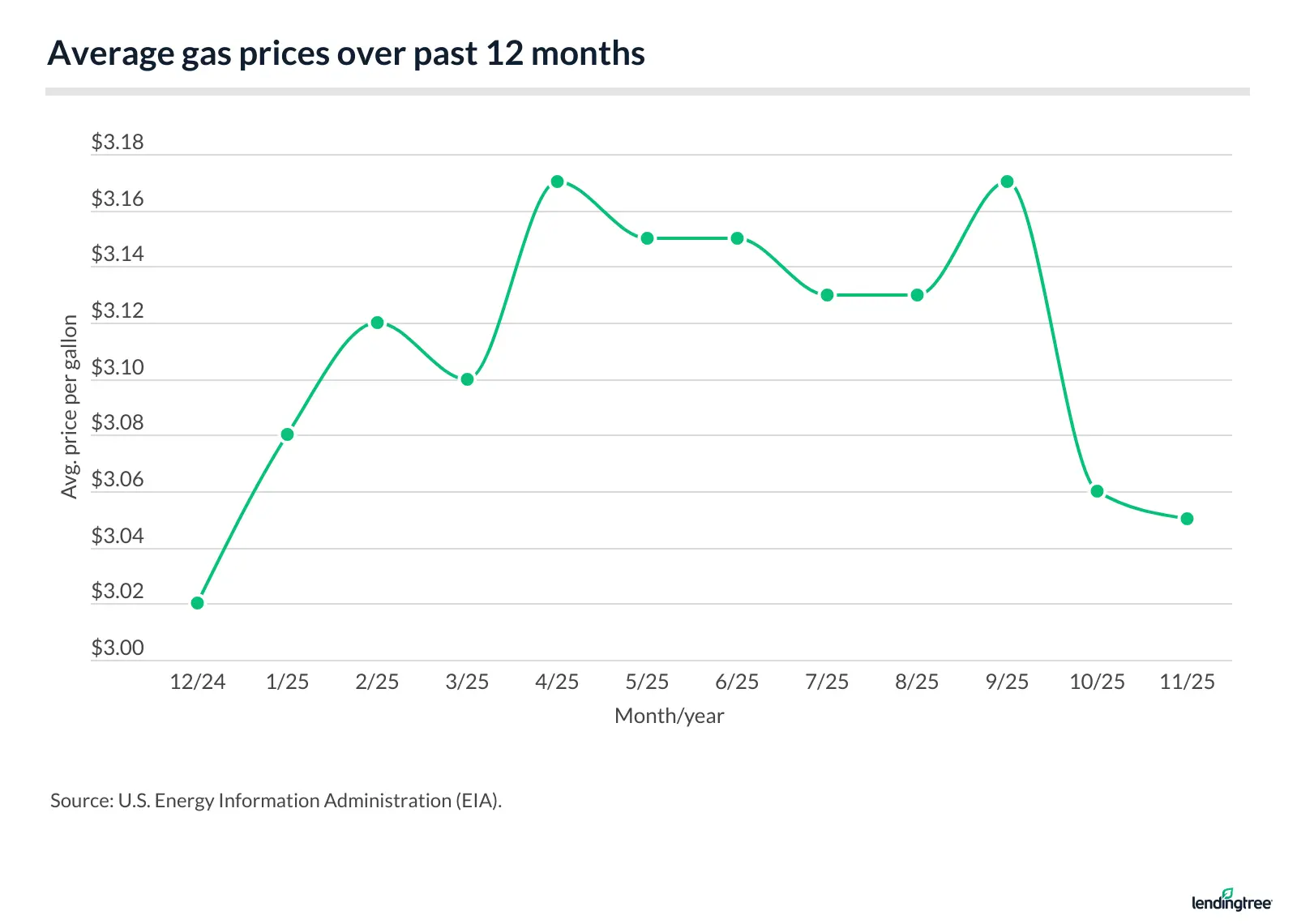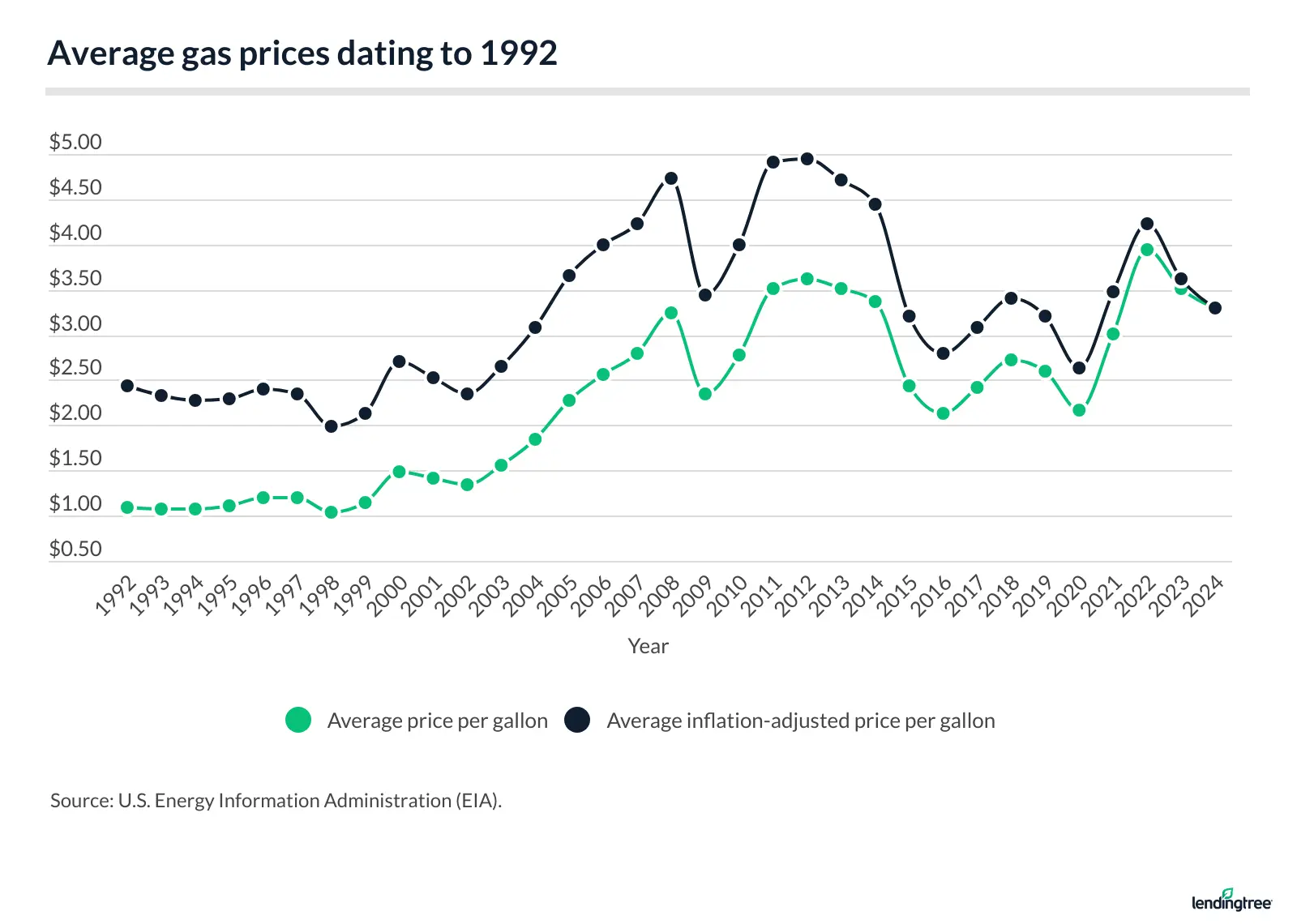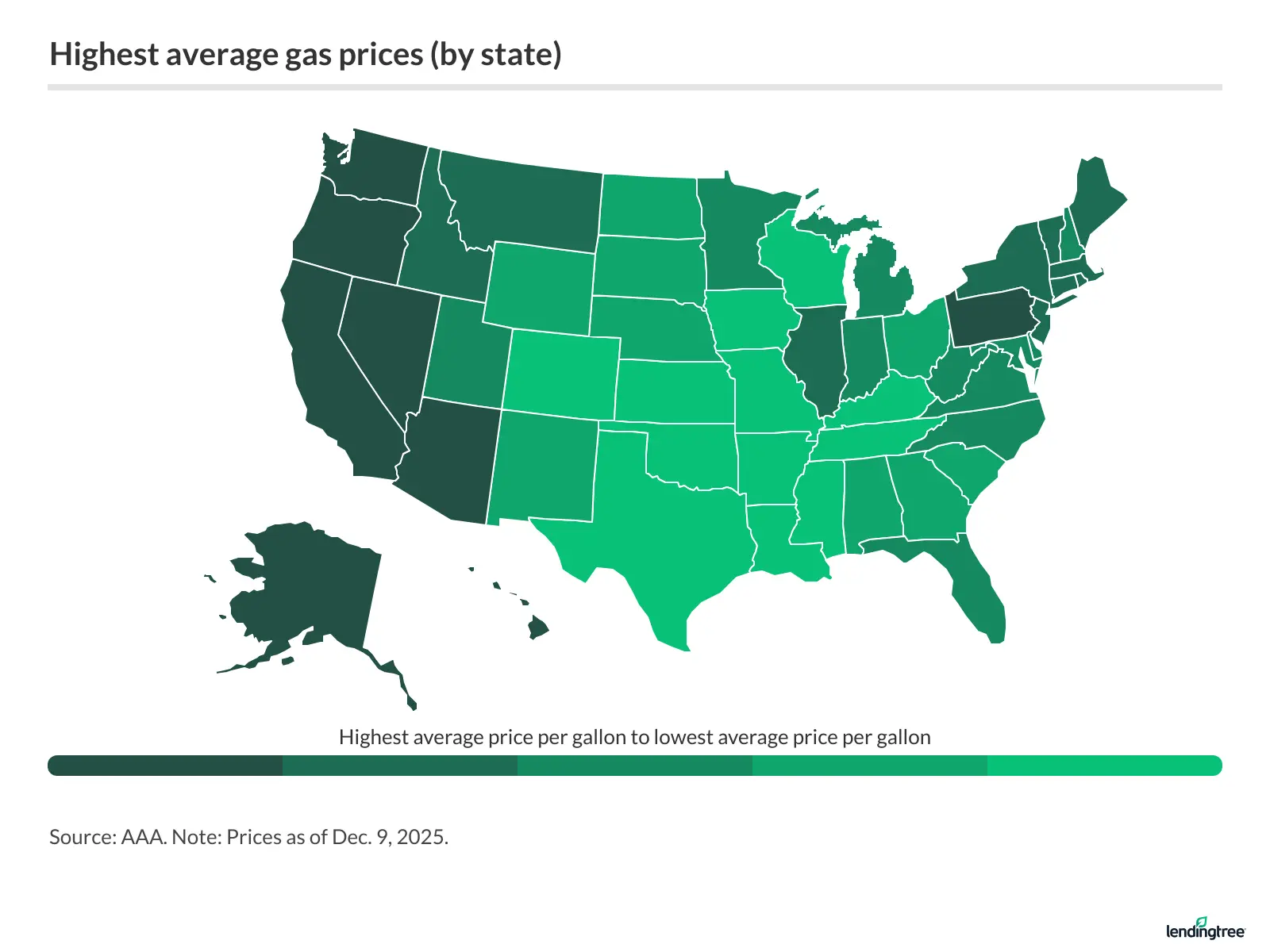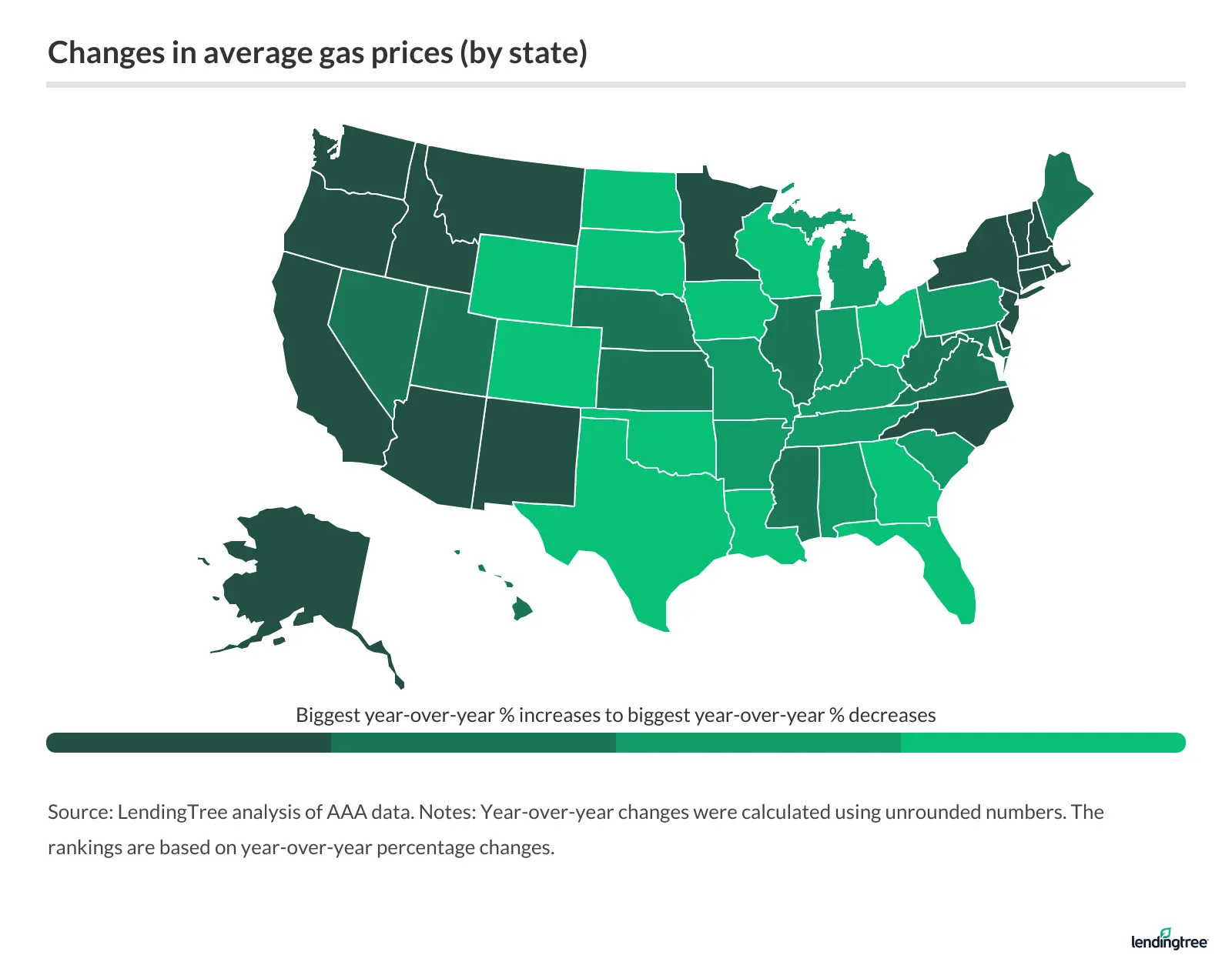US Gas Prices Decrease By As Much As 13% — See Where Your State Stacks Up
- The average U.S. gas price on Dec. 9, 2025, was $2.95 per gallon — down 2.4% from $3.02 a year ago.
- The highest average monthly gas price per gallon so far in 2025 was $3.17 in September and April, while the lowest was $3.05 in November.
- The average gas price per gallon in 2024 was $3.30, down 6.1% from $3.52 in 2023 and 16.4% from $3.95 in 2022.
- The highest average gas prices are in California ($4.45 per gallon), Hawaii ($4.44) and Washington ($4.08).
- Oklahoma has the lowest average gas price ($2.37 per gallon), ahead of Colorado ($2.48) and Texas ($2.50).
- Average gas prices increased the most between Dec. 9, 2024, and Dec. 9, 2025, in Alaska (7.3%), Oregon (5.4%) and Montana (3.2%).
- Average gas prices decreased the most between Dec. 9, 2024, and Dec. 9, 2025, in Colorado (12.6%), Wyoming (8.7%) and Florida (7.6%).
- By metro, average gas prices jumped the most in Juneau, Alaska (13.7%), Pendleton, Ore. (10.6%), and Clarkston, Wash. (9.4%).
- By metro, average gas prices decreased the most in Glenwood Springs, Colo. (22.5%), Casper, Wyo. (18.1%), and Cheyenne, Wyo. (16.8%).
Average monthly gas prices are down $1.88 per gallon from their peak in June 2022, according to a LendingTree analysis.
Meanwhile, average daily gas prices are down 2.4% year over year as of Dec. 9. By state, prices increased by 7.3% in Alaska and decreased by 12.6% in Colorado.
We examined the largest fluctuations in gas prices between Dec. 9, 2024, and Dec. 9, 2025. In addition to highlighting which states and metros saw the biggest increases and decreases, we’ll explain how you can use credit card rewards to earn cash back at the pump.
Average gas prices decreased 2.4% nationwide — here’s how they fluctuated
On Dec. 9, 2025, the average U.S. gas price was $2.95 per gallon. That’s down 2.4% from $3.02 on Dec. 9, 2024. This month, the national average dipped below $3.00 for the first time since May 2021.
The average gas price per gallon in 2024 was $3.30, though that’s down from $3.52 in 2023. In 2024, monthly prices peaked at $3.61 in April before gradually declining to a low of $3.02 in December. So far in 2025, the average gas price has been the lowest in November at $3.05 per gallon and the highest in April and September at $3.17.

Average gas prices over past 12 months
| Month | Avg. price per gallon |
|---|---|
| November 2025 | $3.05 |
| October 2025 | $3.06 |
| September 2025 | $3.17 |
| August 2025 | $3.13 |
| July 2025 | $3.13 |
| June 2025 | $3.15 |
| May 2025 | $3.15 |
| April 2025 | $3.17 |
| March 2025 | $3.10 |
| February 2025 | $3.12 |
| January 2025 | $3.08 |
| December 2024 | $3.02 |
It’s worth noting that gas prices have decreased in 2024 and 2025 compared to a few years earlier, in 2022. To put it into perspective, six of the 10 months with the highest average gas prices, dating back to 1992, occurred in 2022 — with the year claiming the top five spots. Notably, the only other months where average gas prices reached over $4.00 a gallon were June and July 2008, when demand was high but global oil production was low.
Highest gas prices (historical)
| Rank | Month | Avg. price per gallon |
|---|---|---|
| 1 | June 2022 | $4.93 |
| 2 | July 2022 | $4.56 |
| 3 | May 2022 | $4.44 |
| 4 | March 2022 | $4.22 |
| 5 | April 2022 | $4.11 |
| 6 | July 2008 | $4.06 |
| 7 | June 2008 | $4.05 |
| 8 | August 2022 | $3.98 |
| 9 | May 2011 | $3.91 |
| 10 | April 2012 | $3.90 |
Still, 2022 wasn’t the worst year for gas prices. When adjusted for inflation, 2012 had the highest average gas price at $4.94 per gallon. Before adjusting for inflation, it was $3.62 per gallon.

Avg. gas prices dating to 1992
| Year | Avg. price per gallon | Avg. inflation-adjusted price per gallon |
|---|---|---|
| 2024 | $3.30 | $3.30 |
| 2023 | $3.52 | $3.62 |
| 2022 | $3.95 | $4.23 |
| 2021 | $3.01 | $3.48 |
| 2020 | $2.17 | $2.63 |
| 2019 | $2.60 | $3.20 |
| 2018 | $2.72 | $3.40 |
| 2017 | $2.42 | $3.09 |
| 2016 | $2.14 | $2.80 |
| 2015 | $2.43 | $3.21 |
| 2014 | $3.36 | $4.45 |
| 2013 | $3.51 | $4.72 |
| 2012 | $3.62 | $4.94 |
| 2011 | $3.52 | $4.91 |
| 2010 | $2.78 | $4.00 |
| 2009 | $2.35 | $3.44 |
| 2008 | $3.25 | $4.73 |
| 2007 | $2.80 | $4.23 |
| 2006 | $2.57 | $4.00 |
| 2005 | $2.27 | $3.65 |
| 2004 | $1.85 | $3.08 |
| 2003 | $1.56 | $2.66 |
| 2002 | $1.35 | $2.35 |
| 2001 | $1.42 | $2.52 |
| 2000 | $1.48 | $2.70 |
| 1999 | $1.14 | $2.14 |
| 1998 | $1.03 | $1.98 |
| 1997 | $1.20 | $2.34 |
| 1996 | $1.20 | $2.40 |
| 1995 | $1.11 | $2.29 |
| 1994 | $1.08 | $2.28 |
| 1993 | $1.07 | $2.32 |
| 1992 | $1.09 | $2.43 |
Average gas prices highest in California, lowest in Oklahoma
As of Dec. 9, 2025, the highest average gas price is in California ($4.45 per gallon). Hawaii ($4.44) and Washington ($4.08) follow.
States with highest average gas prices
| Rank | State | Avg. price per gallon |
|---|---|---|
| 1 | California | $4.45 |
| 2 | Hawaii | $4.44 |
| 3 | Washington | $4.08 |
| 4 | Oregon | $3.70 |
| 5 | Alaska | $3.65 |
Conversely, Oklahoma has the lowest average gas price at $2.37 per gallon, ahead of Colorado ($2.48) and Texas ($2.50).
States with lowest average gas prices
| Rank | State | Avg. price per gallon |
|---|---|---|
| 1 | Oklahoma | $2.37 |
| 2 | Colorado | $2.48 |
| 3 | Texas | $2.50 |
| 4 | Arkansas | $2.52 |
| 5 | Iowa | $2.55 |
Full rankings

Highest average gas prices (by state)
| Rank | State | Avg. price per gallon | % difference from avg. U.S. gas price |
|---|---|---|---|
| 1 | California | $4.45 | 51.1% |
| 2 | Hawaii | $4.44 | 50.8% |
| 3 | Washington | $4.08 | 38.5% |
| 4 | Oregon | $3.70 | 25.6% |
| 5 | Alaska | $3.65 | 23.9% |
| 6 | Nevada | $3.59 | 21.9% |
| 7 | Arizona | $3.23 | 9.7% |
| 8 | District of Columbia | $3.20 | 8.7% |
| 9 | Pennsylvania | $3.17 | 7.6% |
| 10 | New York | $3.11 | 5.6% |
| 10 | Vermont | $3.11 | 5.6% |
| 12 | Idaho | $3.10 | 5.3% |
| 13 | Illinois | $3.09 | 4.9% |
| 14 | Connecticut | $3.05 | 3.6% |
| 15 | Massachusetts | $3.02 | 2.5% |
| 16 | Maine | $3.00 | 1.9% |
| 17 | New Jersey | $2.97 | 0.8% |
| 17 | Rhode Island | $2.97 | 0.8% |
| 19 | Montana | $2.95 | 0.2% |
| 20 | New Hampshire | $2.93 | -0.5% |
| 21 | Utah | $2.91 | -1.2% |
| 22 | Maryland | $2.90 | -1.5% |
| 23 | Florida | $2.89 | -1.9% |
| 24 | Delaware | $2.88 | -2.2% |
| 25 | West Virginia | $2.86 | -2.9% |
| 26 | Virginia | $2.85 | -3.2% |
| 27 | Michigan | $2.84 | -3.6% |
| 28 | North Carolina | $2.82 | -4.2% |
| 29 | Indiana | $2.79 | -5.3% |
| 29 | Minnesota | $2.79 | -5.3% |
| 31 | Georgia | $2.78 | -5.6% |
| 32 | New Mexico | $2.74 | -7.0% |
| 33 | Wyoming | $2.70 | -8.3% |
| 33 | South Dakota | $2.70 | -8.3% |
| 33 | North Dakota | $2.70 | -8.3% |
| 36 | Ohio | $2.68 | -9.0% |
| 37 | South Carolina | $2.67 | -9.3% |
| 37 | Nebraska | $2.67 | -9.3% |
| 39 | Alabama | $2.64 | -10.4% |
| 40 | Kentucky | $2.63 | -10.7% |
| 41 | Kansas | $2.62 | -11.0% |
| 42 | Missouri | $2.60 | -11.7% |
| 42 | Tennessee | $2.60 | -11.7% |
| 44 | Wisconsin | $2.59 | -12.1% |
| 45 | Louisiana | $2.57 | -12.7% |
| 46 | Mississippi | $2.56 | -13.1% |
| 47 | Iowa | $2.55 | -13.4% |
| 48 | Arkansas | $2.52 | -14.4% |
| 49 | Texas | $2.50 | -15.1% |
| 50 | Colorado | $2.48 | -15.8% |
| 51 | Oklahoma | $2.37 | -19.5% |
Where average gas prices jumped and fell the most
It’s also worth noting which states saw the biggest year-over-year changes. Average gas prices increased in 10 states between Dec. 9, 2024, and Dec. 9, 2025.
In Alaska, the average gas price increased by 7.3% from $3.40 to $3.65 per gallon. Oregon followed with a 5.4% increase from $3.51 to $3.70, then Montana with a 3.2% increase from $2.85 to $2.95.
States with biggest increases in average gas prices
| Rank | State | Avg. gas price, Dec. 9, 2025 | Avg. gas price, Dec. 9, 2024 | YoY % change | YoY $ change |
|---|---|---|---|---|---|
| 1 | Alaska | $3.65 | $3.40 | 7.3% | $0.25 |
| 2 | Oregon | $3.70 | $3.51 | 5.4% | $0.19 |
| 3 | Montana | $2.95 | $2.85 | 3.2% | $0.09 |
| 4 | Washington | $4.08 | $3.97 | 3.0% | $0.12 |
| 5 | Idaho | $3.10 | $3.02 | 2.4% | $0.07 |
Meanwhile, the average gas prices in Colorado decreased the most between Dec. 9, 2024, and Dec. 9, 2025. Here, gas prices fell 12.6% from $2.84 to $2.48. Wyoming, where prices fell 8.7% from $2.95 to $2.70, and Florida, where prices fell 7.6% from $3.12 to $2.89, followed.
States with biggest decreases in average gas prices
| Rank | State | Avg. gas price, Dec. 9, 2025 | Avg. gas price, Dec. 9, 2024 | YoY % change | YoY $ change |
|---|---|---|---|---|---|
| 1 | Colorado | $2.48 | $2.84 | -12.6% | -$0.36 |
| 2 | Wyoming | $2.70 | $2.95 | -8.7% | -$0.26 |
| 3 | Florida | $2.89 | $3.12 | -7.6% | -$0.24 |
| 4 | Ohio | $2.68 | $2.83 | -5.5% | -$0.16 |
| 5 | Wisconsin | $2.59 | $2.73 | -5.2% | -$0.14 |
Full rankings

Changes in average gas prices (by state)
| Rank | State | Avg. gas price, Dec. 9, 2025 | Avg. gas price, Dec. 9, 2024 | YoY % change | YoY $ change |
|---|---|---|---|---|---|
| 1 | Alaska | $3.65 | $3.40 | 7.3% | $0.25 |
| 2 | Oregon | $3.70 | $3.51 | 5.4% | $0.19 |
| 3 | Montana | $2.95 | $2.85 | 3.2% | $0.09 |
| 4 | Washington | $4.08 | $3.97 | 3.0% | $0.12 |
| 5 | Idaho | $3.10 | $3.02 | 2.4% | $0.07 |
| 6 | California | $4.45 | $4.37 | 1.9% | $0.08 |
| 7 | Arizona | $3.23 | $3.18 | 1.6% | $0.05 |
| 8 | New Jersey | $2.97 | $2.95 | 0.6% | $0.02 |
| 8 | Rhode Island | $2.97 | $2.95 | 0.6% | $0.02 |
| 10 | Delaware | $2.88 | $2.87 | 0.4% | $0.01 |
| 11 | Connecticut | $3.05 | $3.05 | 0.0% | $0.00 |
| 12 | Vermont | $3.11 | $3.11 | -0.2% | -$0.01 |
| 13 | Massachusetts | $3.02 | $3.03 | -0.3% | -$0.01 |
| 14 | North Carolina | $2.82 | $2.84 | -0.6% | -$0.02 |
| 15 | Minnesota | $2.79 | $2.82 | -0.8% | -$0.02 |
| 15 | New Hampshire | $2.93 | $2.96 | -0.8% | -$0.03 |
| 17 | New Mexico | $2.74 | $2.76 | -0.9% | -$0.03 |
| 18 | New York | $3.11 | $3.15 | -1.1% | -$0.03 |
| 18 | District of Columbia | $3.20 | $3.23 | -1.1% | -$0.04 |
| 20 | Utah | $2.91 | $2.96 | -1.4% | -$0.04 |
| 20 | Virginia | $2.85 | $2.89 | -1.4% | -$0.04 |
| 22 | Nevada | $3.59 | $3.64 | -1.5% | -$0.05 |
| 23 | Kansas | $2.62 | $2.66 | -1.6% | -$0.04 |
| 24 | Illinois | $3.09 | $3.15 | -1.8% | -$0.06 |
| 24 | Maine | $3.00 | $3.05 | -1.8% | -$0.06 |
| 26 | Mississippi | $2.56 | $2.61 | -2.0% | -$0.05 |
| 27 | Hawaii | $4.44 | $4.54 | -2.2% | -$0.10 |
| 28 | Maryland | $2.90 | $2.97 | -2.4% | -$0.07 |
| 29 | West Virginia | $2.86 | $2.94 | -2.5% | -$0.07 |
| 29 | Nebraska | $2.67 | $2.74 | -2.5% | -$0.07 |
| 31 | South Carolina | $2.67 | $2.74 | -2.7% | -$0.07 |
| 31 | Kentucky | $2.63 | $2.70 | -2.7% | -$0.07 |
| 33 | Tennessee | $2.60 | $2.67 | -2.9% | -$0.08 |
| 34 | Pennsylvania | $3.17 | $3.26 | -3.0% | -$0.10 |
| 34 | Michigan | $2.84 | $2.93 | -3.0% | -$0.09 |
| 36 | Missouri | $2.60 | $2.68 | -3.1% | -$0.08 |
| 37 | Alabama | $2.64 | $2.74 | -3.5% | -$0.10 |
| 37 | Indiana | $2.79 | $2.89 | -3.5% | -$0.10 |
| 39 | Arkansas | $2.52 | $2.62 | -3.7% | -$0.10 |
| 40 | Texas | $2.50 | $2.60 | -3.9% | -$0.10 |
| 40 | South Dakota | $2.70 | $2.81 | -3.9% | -$0.11 |
| 42 | Georgia | $2.78 | $2.90 | -4.1% | -$0.12 |
| 43 | Iowa | $2.55 | $2.67 | -4.6% | -$0.12 |
| 44 | Oklahoma | $2.37 | $2.49 | -4.8% | -$0.12 |
| 45 | Louisiana | $2.57 | $2.71 | -4.9% | -$0.13 |
| 45 | North Dakota | $2.70 | $2.83 | -4.9% | -$0.14 |
| 47 | Wisconsin | $2.59 | $2.73 | -5.2% | -$0.14 |
| 48 | Ohio | $2.68 | $2.83 | -5.5% | -$0.16 |
| 49 | Florida | $2.89 | $3.12 | -7.6% | -$0.24 |
| 50 | Wyoming | $2.70 | $2.95 | -8.7% | -$0.26 |
| 51 | Colorado | $2.48 | $2.84 | -12.6% | -$0.36 |
Biggest metro increases in Alaska, Oregon
Metros (as designated by AAA) in Alaska and Oregon saw the largest average gas price increases. Of the 10 metros with the highest gas price increases, three are in Alaska and three are in Oregon.
Juneau, Alaska, saw the largest increase, with gas prices rising by 13.7% from $3.32 to $3.78. This was followed by Pendleton, Ore., where prices increased 10.6%, from $3.30 to $3.65, and by Clarkston, Wash., with a 9.4% increase from $3.40 to $3.72.
Metros with biggest increases in average gas prices
| Rank | Metro | Avg. gas price, Dec. 9, 2025 | Avg. gas price, Dec. 9, 2024 | YoY % change | YoY $ change |
|---|---|---|---|---|---|
| 1 | Juneau, AK | $3.78 | $3.32 | 13.7% | $0.46 |
| 2 | Pendleton, OR | $3.65 | $3.30 | 10.6% | $0.35 |
| 3 | Clarkston, WA | $3.72 | $3.40 | 9.4% | $0.32 |
| 4 | Fairbanks, AK | $3.64 | $3.35 | 8.7% | $0.29 |
| 5 | Bend, OR | $3.60 | $3.33 | 8.0% | $0.27 |
| 6 | Anchorage, AK | $3.62 | $3.38 | 7.2% | $0.24 |
| 7 | Salem, OR | $3.63 | $3.40 | 6.8% | $0.23 |
| 8 | Twin Falls, ID | $3.18 | $3.00 | 6.0% | $0.18 |
| 9 | Laredo, TX | $2.62 | $2.47 | 5.8% | $0.15 |
| 10 | Carbondale-Marion, IL | $3.02 | $2.86 | 5.7% | $0.16 |
Meanwhile, average gas prices decreased the most in Glenwood Springs, Colo., falling by 22.5% from $3.50 to $2.71. Following closely are Casper, Wyo., where prices decreased by 18.1% from $2.75 to $2.25, and Cheyenne, Wyo., where prices dropped by 16.8% from $2.98 to $2.48.
Metros with biggest decreases in average gas prices
| Rank | Metro | Avg. gas price, Dec. 9, 2025 | Avg. gas price, Dec. 9, 2024 | YoY % change | YoY $ change |
|---|---|---|---|---|---|
| 1 | Glenwood Springs, CO | $2.71 | $3.50 | -22.5% | -$0.79 |
| 2 | Casper, WY | $2.25 | $2.75 | -18.1% | -$0.50 |
| 3 | Cheyenne, WY | $2.48 | $2.98 | -16.8% | -$0.50 |
| 4 | Denver, CO | $2.32 | $2.75 | -15.6% | -$0.43 |
| 5 | Greeley, CO | $2.26 | $2.64 | -14.4% | -$0.38 |
| 6 | Superior, WI | $2.42 | $2.82 | -14.1% | -$0.40 |
| 7 | Pueblo, CO | $2.42 | $2.82 | -14.0% | -$0.40 |
| 8 | Colorado Springs, CO | $2.30 | $2.66 | -13.7% | -$0.36 |
| 9 | Waterloo-Cedar Falls, IA | $2.48 | $2.84 | -12.7% | -$0.36 |
| 9 | Boulder-Longmont, CO | $2.52 | $2.89 | -12.7% | -$0.37 |
Utilizing credit cards for cash back at the gas station: Expert tips
The U.S. Energy Information Administration (EIA) forecasts gas to be $3.00 per gallon in 2026.
LendingTree chief consumer finance analyst Matt Schulz says drivers can take a few steps to save on gas at the pump. His first tip? Shop around.
“It doesn’t make sense to drive across town to save 3 cents a gallon, but gas prices can vary quite a bit even in a small area,” he says. “Driving an extra few blocks for a lower gas price can add up over a year, depending on how often you fill up.”
Next, Schulz advises leveraging credit cards with the best gas station rewards.
“Whether you’re loyal to one specific gas station chain or just looking to save on gas prices no matter where you fill up, plenty of credit cards can help you,” he says. “Just know that gas station-specific cards tend to have higher-than-average APRs, so make sure you pay them off in full every month if you’re going to use them. Otherwise, the amount you save on gas can quickly be outweighed by how much you accrue in interest.”
Expert insight
LendingTree is curating an exclusive panel of professionals, spanning various areas of expertise, to help dissect difficult subjects and empower you to make smarter financial decisions. Read on for more gas price insights.
- What are some key indicators to predict gas price trends?
- What are some ways consumers can combat high gas prices?
- In light of current gas prices, what are the financial benefits and considerations in investing in a more fuel-efficient car or electric vehicle?
Investing in a more fuel-efficient vehicle can reduce how much you spend on gas. However, whether it makes sense to go out and buy one depends on more than just current gas prices.
Predicting the future is difficult. However, one way to get a sense of what may happen to gas prices in the future is by looking at the price of oil futures. These contracts provide a view of what people think will happen to oil prices. As these prices rise, future gas prices will also likely increase. This approach is imperfect, as the people buying and selling these contracts may be wrong about future oil prices. Nonetheless, it can be a helpful data point when planning for higher gas prices.
The strategies consumers can adopt to combat high gas prices depend on how long they expect prices to remain high. If the price increase is temporary, carpooling or working from home temporarily can provide relief. More drastic changes may be needed if consumers expect the gas price to stay high for a long time. For example, investing in a more fuel-efficient car or electric vehicle (EV) may make sense. Consumers may also consider relocating to be closer to their jobs.
Investing in a more fuel-efficient vehicle can reduce how much you spend on gas. However, whether it makes sense to go out and buy one depends on more than just current gas prices. For example, a more fuel-efficient vehicle enables you to drive more miles per gallon. As a result, you may drive more miles than you would with a less fuel-efficient vehicle, potentially increasing your total spending on gas.
Another factor you should consider is how long you expect gas prices to remain high. For instance, you would not want to go out and buy a new, more fuel-efficient vehicle if you expect gas prices to stay high for only a short period. The benefits of switching thus depend, in part, on how long high gas prices will last. The longer you expect gas prices to remain high, the more it makes sense to consider investing in a more fuel-efficient vehicle. The same point applies to electric cars.
On the note of electric cars, while you can avoid high gas prices by investing in one, you must pay for electricity. Energy prices often move together, so electricity prices may also increase when gas prices increase. In addition, there are other costs associated with owning an electric vehicle that can offset the benefits of switching from a gas-powered car, such as higher insurance costs. For these reasons, do your homework before switching to an electric vehicle.
The cost to charge an electric vehicle: Public vs. at-home charging
Methodology
LendingTree researchers analyzed AAA data on average regular gas prices in states and metros. Prices are as of Dec. 9, 2025, and are compared to those on Dec. 9, 2024.
U.S. Energy Information Administration (EIA) data was used to calculate average historical prices of regular gas per gallon.


